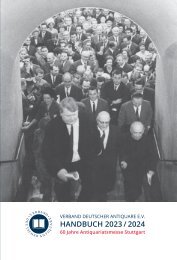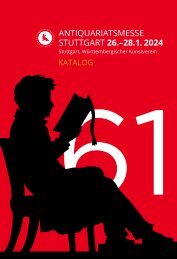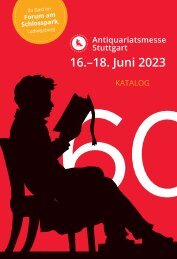Antiquariatsmesse Stuttgart 2022 - Katalog
Katalog zur Antiquariatsmesse Stuttgart 2022: Die diesjährige Antiquariatsmesse Stuttgart, Deutschlands bedeutendste Messe für schöne und seltene Bücher, Autographen, illustrierte Werke und Graphik findet, wie bereits im vergangenen Jahr pandemiebedingt nicht als klassische Messe, sondern in Form des gedruckten Kataloges und als digitale Messe auf bewährter Plattform (18. bis 22. Februar 2022) statt. 73 Antiquariate und Galerien aus Deutschland, Österreich und der Schweiz, den Niederlanden, Frankreich, England und den USA werden auch in diesem Jahr die gesamte Bandbreite des Antiquariatshandels präsentieren. Der gedruckte Katalog wird ab dem 31. Januar 2022 an interessierte Kunden verschickt, die virtuelle Messe öffnet ihre „digitalen Pforten“ am 18. Februar 2022 um 12.00 Uhr unter www.antiquariatsmesse-stuttgart.de
Katalog zur Antiquariatsmesse Stuttgart 2022: Die diesjährige Antiquariatsmesse Stuttgart, Deutschlands bedeutendste Messe für schöne und seltene Bücher, Autographen, illustrierte Werke und Graphik findet, wie bereits im vergangenen Jahr pandemiebedingt nicht als klassische Messe, sondern in Form des gedruckten Kataloges und als digitale Messe auf bewährter Plattform (18. bis 22. Februar 2022) statt.
73 Antiquariate und Galerien aus Deutschland, Österreich und der Schweiz, den Niederlanden, Frankreich, England und den USA werden auch in diesem Jahr die gesamte Bandbreite des Antiquariatshandels präsentieren.
Der gedruckte Katalog wird ab dem 31. Januar 2022 an interessierte Kunden verschickt, die virtuelle Messe öffnet ihre „digitalen Pforten“ am 18. Februar 2022 um 12.00 Uhr unter www.antiquariatsmesse-stuttgart.de
Sie wollen auch ein ePaper? Erhöhen Sie die Reichweite Ihrer Titel.
YUMPU macht aus Druck-PDFs automatisch weboptimierte ePaper, die Google liebt.
Pharmacology, mineral springs<br />
and sympathetic healing<br />
Gogler, Carl von. Erneuerte Hauß- und Feld-Apotheck,<br />
… Frankfurt am Main, Martin Hallervorden<br />
(printed by Johann Andrea, Königsberg), 1674.<br />
With engraved frontispiece. With: (2) Digby, Kenelm.<br />
Eröffnung unterschiedlicher Heimlichkeiten<br />
der Natur. [Frankfurt am Main], Balthasar Christoph<br />
Wusten, 1671. With engraved frontispiece.<br />
(3) Tabernaemontanus, Jacobus Theodorus. New<br />
Wasserschatz, … Frankfurt am Main, (colophon:<br />
Nicolaus Bassæus), 1593. 4 works (2 published<br />
together with a 3-page publisher’s book list) in 1<br />
volume. 8°. Richly blind-tooled 17th-century pigskin,<br />
with brass clasps on leather thongs. € 6000,–<br />
Four rare German works on pharmacology, mineral<br />
springs and “sympathetic” healing powder, published<br />
as three editions. – Ad 1: Very rare second edition, extensively<br />
revised, of a practical “home and field apothecary”.<br />
Gogler’s book is arranged in nine chapters,<br />
each devoted to a different subject, plus an appendix<br />
on bloodletting. The subjects include various parts of<br />
the body, women and children, ailments and medicine.<br />
– Ad 2: Fifth edition in German of Digby’s famous<br />
oration on “the powder of sympathy”. His mysterious<br />
powder (composed primarily of copper sulfate) was<br />
supposed to cure a wound “sympathetically,” even<br />
from a great distance, when rubbed on the (bloody)<br />
weapon that inflicted it. It is accompanied by a German<br />
translation of the 1642 treatise on the same subject by<br />
Petrus Servius of Spoleto (d. 1648), with a recipe for<br />
making the powder on the last four pages. – Ad 3:<br />
Second edition of Tabernaemontanus’s (1520–1590)<br />
account of naturally carbonated mineral springs. He<br />
covers all such springs known to him in the German<br />
states, in particular that at Bad Schwalbach near Wiesbaden.<br />
He discusses the powers of these springs to<br />
cure illnesses. – With a bookplate on pastedown and a<br />
17th-century owner’s inscription on the title-page of ad<br />
3. The margins are trimmed fairly close to the text, and<br />
the fore edge margin of two leaves reinforced. Further<br />
in very good condition, with only minor browning and<br />
an occasional spot or marginal stain.<br />
Splendid ceremonies at the Württemberg court<br />
Hulsen, Esaias von. Aigentliche Wahrhaffte Delineatio[n]<br />
unnd Abbildung aller Fürstlichen Auffzüg<br />
und Rütterspilen …. [<strong>Stuttgart</strong>], Esaias von Hulsen,<br />
[1617]. With an engraved allegorical title-page and<br />
91 (out of 92) numbered engraved plates. With: (2)<br />
Weckherlin, Georg Rodolf. Kurtze Beschreibung<br />
dess zu Stutgarten, bey den fürstlichen Kindtauf<br />
und Hochzeit jüngst-gehaltenen Frewden-Fests.<br />
Tübingen, Dietrich Werlin, 1618. An extra leaf is<br />
bound between pp. 4 and 5: “Cartel, und Articul<br />
beym Ringrennen”. 2 volumes in 1. Oblong 2°<br />
(28 × 35 cm). Contemporary richly blind-tooled<br />
pigskin, remnants of ties. € 19 500,–<br />
Extremely rare first and only edition of two volumes<br />
that illustrate and describe two festivities: the baptism<br />
of Prince Ulrich von Württemberg (<strong>Stuttgart</strong><br />
1617–1671), son of Duke Johann Friedrich von Württemberg<br />
(1582–1628) and the marriage of the Duke’s<br />
brother Lüdwig Friedrich and Magdalena Elisabeth,<br />
countess of Hessen. – Ad 1: Series of engraved plates<br />
depicting the festival. Although the book is by Esaias<br />
van Hulsen, one of the engraved title-plates, no. 23, is<br />
signed by Matthäus Merian. The series following this<br />
plate (ns. 23–30) are ascribed to Merian whereas some<br />
of the other series are believed to have been made by<br />
Friedrich Brentel, his name and monogram appearing<br />
on 13 plates. The main theory is that Merian and Brentel<br />
are responsible for the plates with their signature<br />
and that the rest of the plates can be ascribed to Van<br />
Hulsen. Some of the engravings had been already used<br />
for Van Hulsen’s “Festzug” of 1616. – Ad 2: Description<br />
of the illustrations of the festivities in the first<br />
work, and explanation of the regulations issued for the<br />
festivities. Title-page illustrated with a large woodcut<br />
coat-of-arms of Württemberg. Georg Rodolph Weckherlin<br />
(1584–1653) was a well-known poet and served<br />
as Duke Johann Friedrich’s secretary and ambassador.<br />
– Contemporary (?) owner’s inscription in ink on free<br />
endpaper. Ad 1 lacking 1 plate (no. 51.). Some leaves<br />
with tears, some slight foxing at places. Otherwise a<br />
very good copy.<br />
13






